2024 BMW i5 M60 xDrive: What’s It Like to Live With?
We’ll be putting our Top Rated Electric Car through a 20,000-mile test
What do you want to know about?
- What we got and why
- Real-World Range
- Performance
- Comfort
- Technology
- Interior
- Utility
- Miscellaneous
- What We Got and Why?
- by Steven Ewing, Director, Editorial Content
- • Our test vehicle: 2024 BMW i5 M60 xDrive
- • Base MSRP: $85,095
- • MSRP as tested: $95,745

The BMW i5 is a relative newcomer in the EV space. Yet it made such a great impression that it earned the Edmunds Top Rated Electric Car award in its first year on sale. It’s an all-around excellent luxury EV; the decision to add one to our long-term test fleet was a no-brainer.
What Did We Get?
BMW currently offers the i5 in single-motor eDrive40 and dual-motor M60 guise, though a new xDrive40 variant will join the lineup in mid-2024. We like the base eDrive40 plenty — in fact, it exceeded its EPA-estimated driving range by 51 miles in our Edmunds EV Range Test. But for our long-termer, we opted to get the hotter i5 M60.
The i5 M60 has a lithium-ion battery pack with 81.2 kWh of usable capacity, which powers a pair of electric motors — one at each axle. Output is quoted at a whopping 593 horsepower and 586 lb-ft of torque, making this sedan a serious powerhouse.
Why Did We Get It?
Because this specific i5 M60 came from BMW, we didn’t get to spec it ourselves, but you know, we’re really jazzed about the one we got. Cape York Green looks awesome on the new i5, especially with the two-tone 21-inch wheels. Our test vehicle also has the brown Veganza faux-leather upholstery. Would we have ordered the carbon-fiber trim? Probably not. Do we hate it? Nah, it’s fine.
The i5 M60 already comes pretty loaded, but our test car has a few optional extras. The $2,000 Driving Assistance Pro package adds BMW’s Highway Assistant that takes over steering, throttle and braking controls on premapped sections of highway, and the $3,350 Executive pack gives us niceties like a heated steering wheel, panoramic roof and the extremely cool glass controls.
To that, our car adds the $1,500 M Carbon Exterior kit, $1,050 M Sport Professional package, $1,800 21-inch bicolor wheels and the aforementioned $300 carbon-fiber trim. That brings our total as-tested price to $95,745, which includes a $995 destination charge. That’s pretty much as expensive as a new i5 gets.
What’s happened so far?
We put our long-term i5 M60 through our usual instrumented testing regimen, and the results are solid. We recorded a 0-to-60-mph time of 3.6 seconds, which bests BMW’s estimate by one-tenth of a second. Our i5 ran the quarter mile in 11.5 seconds with a trap speed of 122.1 mph. And as for stopping distance, the M60’s larger brakes definitely help matters; the i5 comes to a halt from 60 mph in just 104 feet.
On our skidpad, we recorded lateral g-forces of 0.95, which puts the i5 M60 in good company with other sporty midsize sedans, though it trails its key rival, the Mercedes-AMG EQE sedan, which ripped off a full 1.0 g. The AMG EQE is slightly quieter than the i5 M60 on the highway, too, with the Merc measuring an ambient decibel level of 62.4 at 70 mph, compared to the i5’s 65.5 decibels at the same speed.
According to the EPA, the 2024 i5 M60 has a driving range of anywhere between 240 and 256 miles, depending on wheel size. Our test car has the largest 21-inch wheel option, so we should expect 240 miles of range. But again, the i5 eDrive40 we tested previously far exceeded its EPA rating, so we’re excited to see how our long-termer does on our formalized range test.
BMW loaned Edmunds this vehicle for the purpose of evaluation.
2024 BMW i5 M60 xDrive: Real-World Range
Average lifetime consumption (kWh/100 miles): 39.5
EPA rating (kWh/100 miles): 40 combined ( 40 City / 39 Highway )
Best consumption (kWh/100 miles): 40.1
Best range (miles): 139.8
Current odometer: 9,526
Our i5 M60 went 264 miles in the official Edmunds Range Test
“The EPA estimates an i5 M60 with the 21-inch wheels can go 239 miles on a full charge. (Our test car has the 21s.) Pleasingly, we exceeded that when we subjected our i5 to our independent Edmunds EV Range Test, going 264 miles on a full charge. Opting for the smaller 19- or 20-inch wheels boosts the EPA’s estimate by 11-14 miles, and it’s fair to assume that we’d get a commensurate increase in our Edmunds range test.” — Brent Romans, senior manager, written content
OK, so it went 264 miles. Is that good?
“Ehh, sort of. For starters, know that the 264 miles is with the battery fully charged. To help reduce battery degradation, we here at Edmunds usually charge our test EVs to 80% for daily driving. So that’s a daily range for our i5 M60 in the low 200s. However, you have to take into account that this is a 593-hp sport sedan that prioritizes performance. The M60’s range is also similar to what you get from the Mercedes-AMG EQE sedan. Overall, I’ve found that our M60’s range is good enough for daily commuting and the occasional road trip. But if you do a lot of longer trips, I think you’ll be happier with the longer-range i5 eDrive40.” — Brent Romans, senior manager, written content
2024 BMW i5 M60 xDrive: Performance
Does the i5 live up to its BMW badging?

How is the BMW i5’s acceleration?
“Power delivery in this car is just so perfectly judged; BMW is doing such a great job with their EVs. No matter what the traffic or road conditions, it felt entirely intuitive to get exactly the acceleration I wanted, and transitions are entirely smooth. It’s exactly what I want from a luxury car with some performance cred.” — Will Kaufman, manager, video
How is the BMW i5’s handling?
“Weight transfer is kind of uncanny in this car. At no point in normal driving does the weight feel less than 100% controlled, and weight transfer in corners (especially noticeable if you have an S curve or need to swerve to avoid something in the road) is masterfully smoothed out. It’s another case where performance and luxury meet in this car, you get a lot of confidence and there’s just zero head toss.” — Will Kaufman, manager, video

New nickname: The silent assassin
“This sedan rips when you mat its accelerator pedal. During track testing, our car accelerated from 0 to 60 mph in just 3.6 seconds and cleared the quarter mile in 11.5 seconds. We’ve tested quicker luxury EVs (a Tesla Model S Plaid, for instance) but this is still ridiculously quick. Especially so for people used to gas-powered cars. I had my teenage daughter in the car with me recently and I did a short demo. I whipped around a turn, planted the pedal once the front wheels were pointed straight, and kept it going to a speed I won’t mention here. After I left off, she remarked, ‘Wow! It’s so quiet, and it just whooshes.’ She paused, and added, ‘It’s like an assassin. It’s just there and gone before you know it.'” — Brent Romans, senior manager, written content
2024 BMW i5 M60 xDrive: Comfort
Our thoughts on the BMW i5’s comfort live here

How comfortable is the ride on the BMW i5?
“The suspension on the M60 is a teensy bit firm, and it means over certain bumps there’s a hint of more residual body motion than in something like the iX we had. You just get that suggestion of bounce if you hit certain bumps right. You also feel bumps a bit more strongly than I’d like in a luxury car, but small bumps and road imperfections are ironed out way better than you expect from something with performance aspirations.” — Will Kaufman, manager, video
How comfortable is the BMW i5’s driver’s seat?
“The driver’s seat isn’t my favorite BMW seat. I recall the seats in our old 2018 long-term BMW 540i with tremendous fondness, but the seats in our i5 don’t feel as nicely padded or as supportive, and the headrest feels both a little more intrusive and a touch less cushioned. It’s kind of a bummer that for all the ways this car represents a promising future for Bimmer, the front seats feel like a half-step backwards.” — Will Kaufman, manager, video
How quiet is the i5?
“Put your favorite cliche here. Quiet as a mouse? Quiet as a tomb? Quiet as a mouse in a tomb for mute librarians? Whatever, it’s quiet. I looked up our sound decibel test numbers on our i5. It was a little quieter at standstill than a gas-powered Mercedes E-Class, which makes sense because it’s electric. The two luxury sedans had similar measurements when driving at 70 mph (65.5 db for the i5 compared to 62.6 db for the E-Class). Point is, it’s very quiet, and that makes it easy to hold a conversation with your passenger or enjoy the details of your music.” — Brent Romans, senior manager, written content
2024 BMW i5 M60 xDrive: Technology
Find all our thoughts on the BMW i5’s tech here

Highway Assistant could use a pair of sunglasses
“I finally found something not to like about this car (it took a long time). Our i5 uses BMW’s latest suite of safety technology, including a novel hands-free driving system.
“BMW calls this ‘Highway Assistant,’ and it combines a number of systems into one allowing the car to stay in the lane and maintain its speed without input from the driver. I’ve used it on a number of occasions and found that it works very well — for the most part.
“During a recent outing with the car, I activated the Highway Assistant on the freeway while driving into direct sunlight. With some pretty severe glare coming through the windshield, the car was tricked. The system turned off multiple times and did a poor job of staying in the lane when it was operating. It was the first time that I didn’t feel confident using the technology. Hopefully BMW will improve this over time with over-the-air updates.” — Clint Simone, senior editor

How does iDrive work?
“There’s an annoying quirk with iDrive 8.5, though not one that’s exclusive to our i5. When you use the My Modes button on the center console to switch between the Efficient, Normal (sorry, ‘Personal’) and Sport modes, once you’ve activated the new mode you want, the infotainment screen doesn’t go back to where you were. It just displays the wallpaper of whatever that mode is, so if you were using navigation or Apple CarPlay, you have to press the button on the home screen to get back there.
“A small annoyance, sure, but in a car as otherwise effortless to use as the i5, it really stands out.” — Steven Ewing, director, editorial content
“iDrive isn’t great. I might even go so far as to say it isn’t good. It’s a hassle to find stuff unless you use the search function, and the rotary knob is a tad too sensitive to pushes for my taste. But really, it’s just the fact that simple things are more difficult than they need to be that bugs me. If the voice commands were 100% on point with natural language prompts, I guess it would be fine.” — Will Kaufman, manager, video
“The infotainment display had some ups and some downs. The screen is large, and what I have always loved about the infotainment systems in BMWs is that when you navigate through SiriusXM channels, you can see what song is playing in the display before you click on the channel. Yes. It is the little things.
“But, I must agree with my fellow comrade Will Kaufman’s assessment of the BMW infotainment interface. The i5’s menu structure is not intuitive and looks like someone just added a bunch of apps but did not organize or categorize them in any kind of meaningful way. The result for me was spending lots of time trying to navigate throughout the applications to try to find a certain setting I was looking for.” — Jodi Tourkow, executive director, written content

We’re trying to decide how we feel about one of BMW’s tech features
“The BMW throws up an “uneven road surface” warning in the HUD when there’s a speed bump or a drainage ditch (a constant threat to the suspension and noses of cars in LA) ahead, along with the distance to the bump or dip. I’m kind of impressed that it knows where there are some severe obstacles around where I live…BUT, it’s not perfect. On one road with three speed humps, it apparently doesn’t know about the middle hump and only warns about the first and third. And it didn’t have EVERY drainage ditch on my commute. I’m trying to decide if I like the feature or don’t really care about it. If it got to about 90-95% accuracy, so I felt like I could lean on it more, I’d probably be able to muster a feeling.” — Will Kaufman, manager, video
We recommend leaving the i5 in its default setting
“The secret to loving this car is to never try to adjust any settings. For example, ‘Individual’ is set to the default ‘theme’ in the car. I wondered if I could change that to, say, Efficient or Sport. So if you go into the My Modes menu, select Individual and then select Options, there’s a toggle for having that be the startup mode. But if you tap it, you get an error message that says you have to select another mode before you can deactivate this one as the individual mode. So I select Efficient, but there’s no toggle to make that the startup mode in its settings (either because another mode is already the startup mode, or because you can’t make any mode but Individual the startup mode? In which case, why does the toggle exist at all?). And the only way I can get to the settings for Individual is by selecting Individual, in which case I can’t turn off the startup mode toggle.
“This car’s menu and settings structure feels like the kind of UX solutions you’d get if you trained an AI on the interfaces of ’90s cellphones and homebrew Linux desktops, then asked it to make a touchscreen system based on the concept of ‘app-store functionality.’ ” — Will Kaufman, manager, video

The i5 boots up quite quickly
“Our i5’s tech interface is impressively quick-acting. Hop in the car, press the start button and, boom, everything on the screens is ready to go. There’s no drawn-out boot-up sequence or indecisive dithering, like when your dog can’t decide whether to go outside or not when you open the door and it’s super cold. That same snappiness also holds for the i5’s wireless smartphone connection. I have an iPhone and my phone’s functions, such as music and navigation, are available almost right away when I get in the car. Nice.” — Brent Romans, senior manager, written content
A strange quirk with Apple CarPlay
“For a car that projects such a high-tech image and runs on a pretty advanced operating system, there’s one thing that absolutely baffles me about the i5: When using Apple CarPlay to listen to music, the haptic skip/track buttons on the center console don’t function. That means you’re forced to use either the touchscreen or center console knob to scroll to the on-screen music controls, which isn’t a huge deal, but it’s not as convenient as it would be to use those center console buttons. This may seem nitpicky, but the i5 is the only car I’ve ever experienced this issue in. For a car that’s seemingly so advanced, you would think BMW could have figured out what seems like a very simple task.” — Ryan Greger, social media content strategist
2024 BMW i5 M60 xDrive: Interior
Everything you ever wanted to know about the interior of the BMW i5 is here

What do we think of the accent pieces in the BMW i5?
“I don’t really like the faux cut-glass accents on the dash and doors in full daylight, where they look a little plasticky. But I LOVE them at night. When they’re backlit in the dark, they look about a thousand times nicer and provide really pleasant ambient light.” — Will Kaufman, manager, video

“I agree with my co-worker Will that our i5’s optional glass-trimmed infotainment controller knob looks neat at night. But he overlooked mentioning that the knob can turn into a very bright and annoying reflector of sunlight when the sun is at certain angles. The black plastic surrounding it also reflects sunlight and easily shows smudgy fingerprints and cabin dust. Ew.” — Brent Romans, senior manager, written content
How about the interior design?
“Say what you’d like about BMW’s exterior designs of the last few years (trust me, I get it). But as of late, this company has been producing some of the best interiors in the industry and our i5 is the perfect example of that.
“You can poke and press on any panel and they all feel rock solid. Cheaper black plastics have started creeping into luxury cars lately, but the i5 is free of this sin. The glossy carbon fiber across the dash looks fantastic, as does the ornate strip of ambient lighting that runs 180 degrees around the car. Little details like the crystal control wheel on the center console make things even better.
“BMW nailed the balance between form and function with the i5’s interior, and it is one of most compelling reasons to consider buying one over less expensive rivals like the Tesla Model S.” — Clint Simone, senior editor
“The ambient cabin light bar in the i5 is pretty cool. It stretches the length of the dash and also blends into the front doors. It gives the cabin a techy, upscale appearance without being overdone or distracting. It changes colors based on your driving mode or you can pick your own color for it too.” — Brent Romans, senior manager, written content

A vote in favor of turn signal stalks
“The i5 is an such a strong argument in favor of turn signal stalks. I mean, there’s the obvious ease-of-use value over ditching the stalk for awful buttons … but the BMW has a really nice stalk. The action has an almost oily mechanical clickiness to it that I imagine feels similar to the pens that CEOs use to sign their golden-parachute contracts. It feels like money. One of those little touches that helps elevate the overall experience of the car.” — Will Kaufman, manager, video
2024 BMW i5 M60 xDrive: Utility
What’s the utility of the BMW i5 like?

The trunk isn’t as spacious as you’d think
“BMW says the i5 has a 17.3-cubic-foot trunk. Based on that spec alone, you’d think the i5 has a pretty big trunk. A Honda Accord, for example, has a 16.7-cubic-foot trunk. In real-world use, however, I’ve found that our i5’s trunk doesn’t live up to that 17.3-cube promise. The height of the trunk is short and the overall shape doesn’t allow you to fit bulkier items (such as suitcases) nearly as easy as it should be. The i5 doesn’t have a truly useful rear trunk underfloor storage bin like you get in the Lucid Air or Tesla Model S either.” — Brent Romans, senior manager, written content
2024 BMW i5 M60 xDrive: Miscellaneous
If it doesn’t fit somewhere else, it ends up here!
Scheduling a charging time should be easier
“Plain and simple: Trying to schedule a charging time via the BMW i5 charging interface was a pain in the butt. Unless it’s me (and I am not saying it isn’t), when I would attempt to schedule a charging time of 11 p.m. using my at-home Level 2 charger, the BMW i5 would not allow me to do so unless I also put in a departure time. So, my two options were to select ‘charge immediately’ or add a ‘departure time’ when I wanted to charge. I tried to override this requirement multiple times.
“This is just adding an arbitrary extra step, IMO. Being required to schedule even an arbitrary departure time just so I can charge the vehicles seems irrelevant.” — Jodi Tourkow, executive director, written content
Join Edmunds
2021 Ford F-150 Hybrid: What’s It Like to Live With?
We loved the F-150 PowerBoost hybrid’s power. Its fuel economy? Less so.
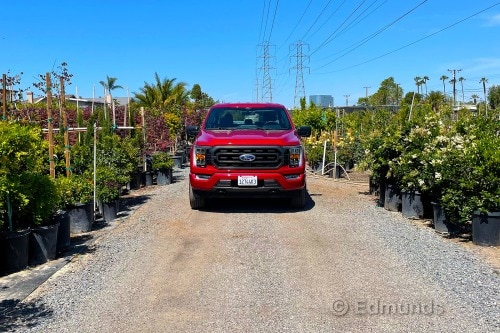
| Miles Driven | Average MPG |
| 47,288 | 19.9 |
Final Takeaways
- Our best fuel fill was 25.6 mpg, a little better than what the EPA promised
- But our overall mpg sat at just under 20 mpg
- We loved the truck’s practicality and usability
- And the ride quality was, unsurprisingly, awesome
What do you want to know about?
- What We Bought and Why
- Real-world fuel economy
- Maintenance and upkeep
- How Does it Drive?
- Ride and Seat Comfort
- Technology
- Interior
- Utility
- Miscellaneous
What We Bought And Why
by Mike Schmidt, Senior Manager, Vehicle Testing Operations
• Our test vehicle: 2021 Ford F-150 PowerBoost Hybrid 4×4 SuperCrew XLT
• Base MSRP: $44,155
• MSRP as tested: $62,285
• What we paid: $66,285
The Ford F-Series has been the best-selling truck (and vehicle) in the United States for more than 40 years. There’s little reason to doubt that this trend will continue with the latest generation F-150 that debuted for the 2021 model year. New for this generation, the F-150 notably gets an available hybrid V6 powertrain. Ford calls it PowerBoost and thinks it can upend the truck segment by delivering more power and better fuel economy than any regular, gas-only engine. So can it? We’ve bought a 2021 F-150 with the PowerBoost powertrain to find out over the course of a year and hopefully 20,000 miles.
What Did We Get?
When it comes to full-size pickups, the configurations are nearly limitless. The F-150 offers six engines (3.3-liter V6, 2.7-liter turbo V6, 5.0-liter V8, 3.0-liter turbodiesel, 3.5-liter turbo V6 and 3.5-liter hybrid), six trim levels (XL, XLT, Lariat, King Ranch, Platinum, Limited), three bed lengths, three cab styles (Regular, SuperCab, SuperCrew), rear-wheel and four-wheel drive. This doesn’t even consider the interior trim and technology options available. We had a few key features in mind as we shopped for our F-150.
On paper, we bought a mouthful: a 2021 Ford F-150 XLT 4×4 SuperCrew with the 5.5-foot bed, 3.5-liter PowerBoost hybrid V6 engine and 10-speed automatic transmission.
Our primary target was the engine and we paid a $4,495 premium for it. This V6 connects to an electric motor and battery pack to produce 430 horsepower and 570 lb-ft of torque. And according to the EPA, this combo is good for an impressive 24 mpg combined (24 city/24 highway).
Our secondary target was the onboard generator ($750), or if you’re reading the spec sheet, the 7.2-kW Pro Power Onboard. We were eager to utilize this feature well before the stories about F-150s powering home appliances in Texas during the North American ice storm of 2021. We look forward to testing the capabilities of this innovative technology.
We otherwise shopped for an F-150 as we’d recommend to a friend. While we’d normally lean toward the Lariat trim, a local Ford dealership had a special-order XLT. The customer backed out so we moved in. The base version of this truck, with an MSRP of $44,155, is well equipped with numerous standard comfort and tech features including as a wireless hotspot, Apple CarPlay and Android Auto integration, and a catalog of driver assist and safety alert systems. The total list of optional equipment totaled $18,435 with the PowerBoost the big-ticket add-on. Other notable items are connected navigation, a tow package, a 360-degree camera package, a spray-in bedliner and 20-inch dark alloy wheels.
The dealer wasn’t going to budge on its $4,000 markup over MSRP, but we accepted this given the wild car market these days and considering it was very near the truck we’d have built ourselves. After a $2,000 Sport package credit, we walked away with a truck for $66,285.
Why Did We Get It?
The F-150 wasn’t the only updated truck in 2021. But at the end of the day, it stands out more than its peers and defends its place atop the class. Each F-150 we’ve owned (2010 F-150 Raptor, the first aluminum 2015 F-150 EcoBoost V6 and a 2018 F-150 EcoBoost) brought its own flair to the F-150 formula. This new F-150 brings a battery pack to the formerly non-hybrid realm of full-size trucks. This F-150 is the new truck to beat and we are excited to spend more time behind the wheel.
What Did We Learn?
We learned that the F-150 PowerBoost hybrid, which uses a 3.5-liter twin-turbo V6 engine and a 1.5-kWh lithium-ion battery, is more interested in power than efficiency. Total system output is a stout 430 horsepower and 570 lb-ft of torque, which is actually more torque than any other F-150 save for the V8-powered Raptor R.
But did the F-150 PowerBoost deliver on its EPA-estimated fuel economy of 24 mpg combined? Not quite. Our lifetime fuel economy came out to 19.9 mpg, which is a far cry from that combined figure. (The city and highway ratings are also 24 mpg, for what it’s worth.) That said, all that torque from the PowerBoost powertrain makes this truck very potent — our XLT hybrid actually beat a V6-powered F-150 Raptor in an off-road drag race. If you get the hybrid setup for the extra torque and not the fuel economy claims, you won’t be disappointed.
And the F-150 was up for every task we threw at it. The XLT PowerBoost we bought can tow up to 12,700 pounds and has a 2,120-pound payload capacity. After plenty of long hauls with all sorts of trailers, praise from our staff was uniquely unanimous. Everyone who towed with the F-150 said the same thing: They could barely feel whatever was behind them.
We’ve also used the F-150 to haul gear everywhere, including using the truck to move apartments, and features like the many tie-down points in the bed and the cab-mounted camera that points directly into the bed all came in extremely handy. The F-150 was a favorite for big moves and long hauls thanks to its easy-to-use tech, great powertrain and smooth ride.
Would we do it again? Absolutely. Our F-150 was a faithful partner that rarely let us down. No, the fuel economy wasn’t what we expected, but we’d happily keep this truck in our fleet for another 40,000-plus miles simply because of how great it was during our long-term test.
Edmunds purchased this vehicle for the purpose of evaluation.
2021 Ford F-150 Hybrid: Real-World Fuel Economy
Everything about the PowerBoost 3.5-liter hybrid V6 that’s fit to print
Average lifetime mpg: 19.9
EPA mpg rating: 24 combined (24 city/24 highway)
Best fill mpg: 25.6
Best range (miles): 700.3
Current odometer: 47,288
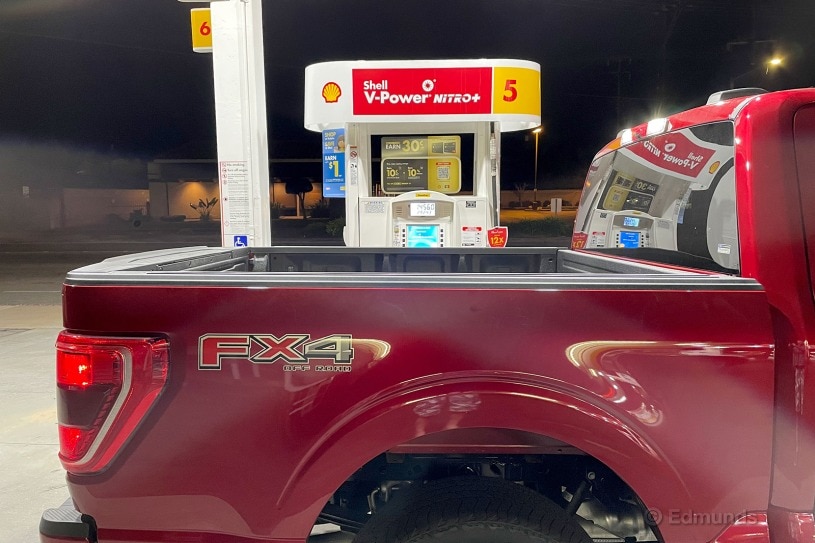
You’re only getting 20 mpg — isn’t this thing a hybrid?
You are not the only one disappointed with the mpg of our F-150 hybrid (thus far, it’ still early days). Here are the thoughts of one Edmunds staffer before we tackle the question in full.
“I recall that when I was in Edmunds’ previous F-150 EcoBoost I got amazing mpg — especially when compared to the RAM 1500. In fact, I drove it to Palm Springs and was able to average between 23-24 mpg, which was amazing. I planned the same drive when I got into the F-150 and couldn’t wait to see how the hybrid engine would do. I was excited to beat the 24 mpg listed on the monroney.
“So, how did it do? Unfortunately, I ended up with a combined 19-20 mpg. Just to let you know, when I drive an electric or hybrid vehicle, my driving behavior changes drastically and instead of stomping on the gas, I find myself trying to optimize the fuel economy. Even with this type of driving, I fell horribly short of the stated mpg. I know that in terms of torque the PowerBoost is impressive, but if you are looking for a full-size truck that gets great mpg, you should look at the EcoBoost. I couldn’t help thinking that is why the PowerBoost literally has zero badging or any markings that points to the fact that this is a hybrid engine.”
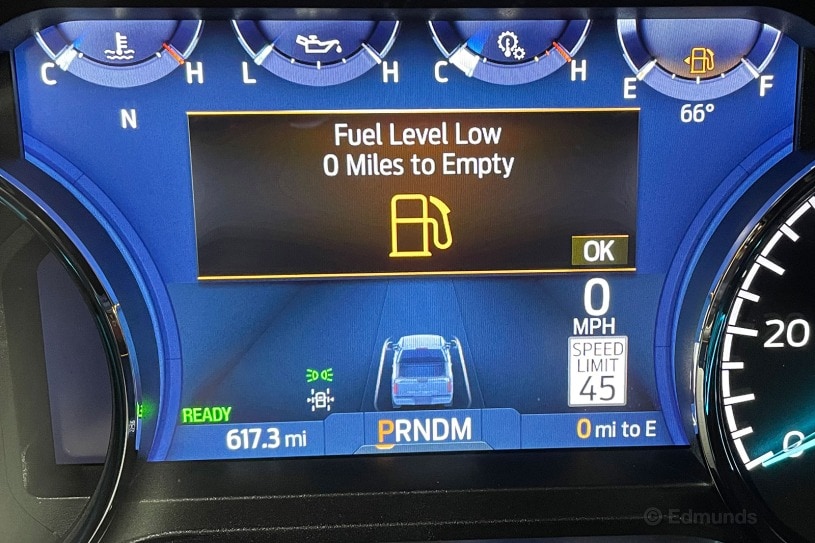
So even driving softly on the highway doesn’t hit the EPA number?
No. The F-150 will drive in “electric mode” or “EV mode” at low speeds (below 30 mph) and will also use its battery when well-charged to take a load off its 3.5-liter V6 engine when traveling upwards of 60 mph. The best way to efficiently use the gas in your tank is to drive on city streets (or better yet, school zones) and brake slowly and deliberately to recharge the battery. Don’t spend a lot of time on interstate highways. This is a hybrid, not a 2009 Honda Civic, so the way you get efficient use of your gasoline is different. It’s also why many find hybrids, well, a little disappointing.” — Jake Sundstrom, editorial assistant
How is the fuel range, though?
So far we haven’t had much luck establishing an average of 20 mpg per tank, let alone the EPA estimate of 24 mpg. Now consider this truck has a 30.6-gallon fuel tank. We’ve consistently gone 500 miles between gas station visits and, under the right circumstances, have seen over 600 miles between fill-ups. That is an impressive stat all by itself. And while we applaud this success, we will conveniently overlook the cost of gasoline these days.
Vehicle Testing Technician Rex Tokeshi-Torres took the F-150 on a long road trip — just over 3,000 miles. And while he set our record for most efficient tank (24.5 mpg) his overall record of 19.7 mpg confirms what we already know nearly 10,000 miles in: If you’re looking for highway fuel efficiency, you best look elsewhere.
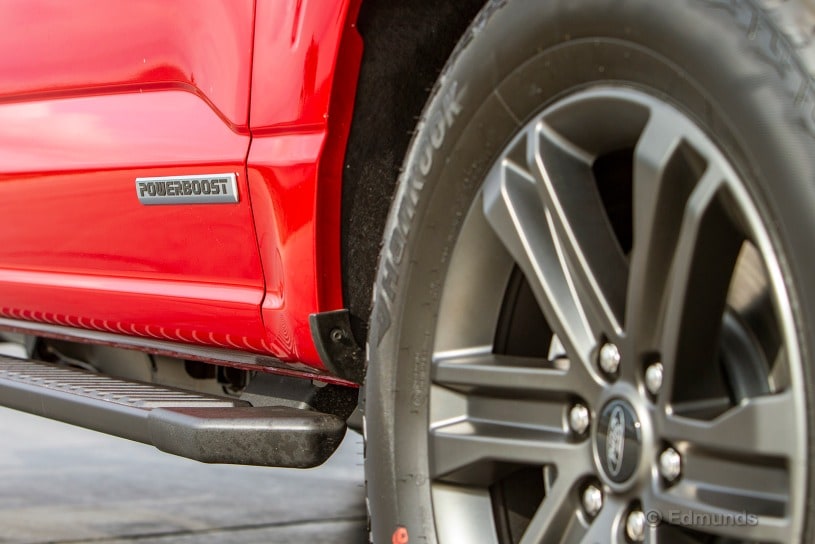
Editor Jake Sundstrom set a new record for both fuel economy and range (25.6 mpg, 700.3 miles) on back-to-back trips while racking up what the F-150 categorizes as “electric miles.” This is when the truck is driving in all-electric mode, something you might be familiar with if you drive a plug-in hybrid or if you’ve followed along with our coverage of vehicles like our Long-Term 2021 Toyota Sienna. Unlike the Sienna, which had a big button that said “EV,” the F-150 isn’t quite as keen on dipping into all-electric mode. That means it’s up to the driver to drive softly at low speeds or let off the gas in areas where coasting is an option to “trick” the truck into switching into battery mode.
This … is kind of silly. The truck drives very smoothly when in all-battery mode and is capable of doing so at freeway speeds when you’ve already got it up and running. It appears more and more that the F-150 Hybrid has the capability of being a (relatively) fuel-efficient vehicle … it’s just not all that interested in it.
The EV Coach feature makes a difference
“Like my co-worker Jake mentioned in another comment, our F-150 isn’t particularly interested in using all-electric power. But there is a way to make the most of the PowerBoost’s hybrid ability: Use the EV Coach feature. If the engine is currently not running, this blue bar readout in the instrument panel shows exactly how far you can press down on the accelerator pedal before the engine will fire back up. As long as you don’t exceed the bar with your throttle input, the truck will stay running with all electric power. I did an informal comparison of my driving style — regular versus EV Coach enhanced — and found that using it helped boost my city driving mpg by 2-3 mpg.” — Brent Romans, senior manager, written content
Driving style, and location, heavily impacts fuel economy
“Unsurprisingly, the F-150’s fuel economy was stronger on the way back from the Grand Canyon than it was on the way there. That’s thanks to the change in elevation — the park sits more than 6,000 feet above sea level and our journey started in Orange County. So, uh, right at sea level. We were able to go all the way from Williams, Arizona, up to the Grand Canyon Village, back to Irvine, California, and on to our headquarters in Santa Monica on one tank. That’s just over 600 miles while averaging a bit better than 22 miles per gallon. Not our best tank but pretty solid for a full-size pickup hauling a bunch of gear. ” — Jake Sundstrom, editor
2021 Ford F-150 Hybrid: Maintenance
All our maintenance experiences from living with the F-150
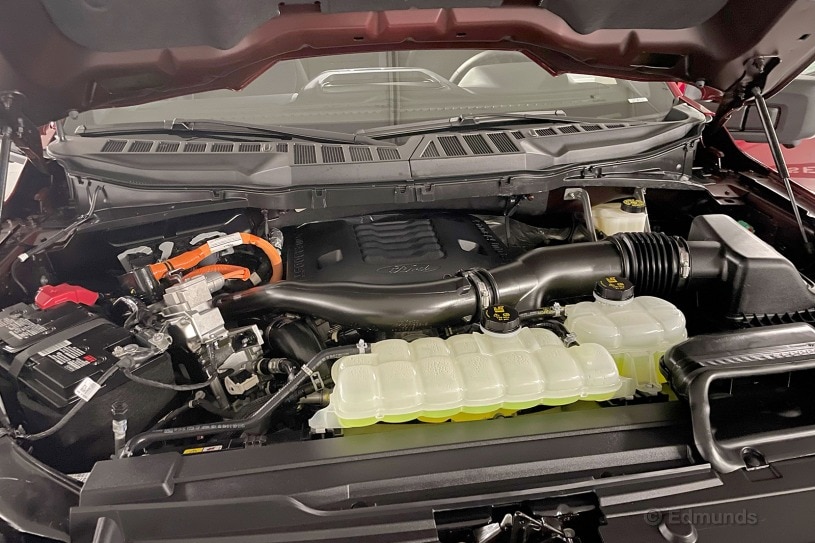
Have there been any issues with the Hybrid?
“The windshield wiper nozzles on our F-150 have either malfunctioned or have somehow gotten clogged. I wanted to clean the windshield the other day, pressed the button and got a slow dribble rather than a powerful spray. We may need to take this in to the dealer to have it checked out.” — Ron Montoya, senior editor
“We’re due for our second oil change. This time we took the F-150 in to a Jiffy Lube in Huntington Beach and got full synthetic oil, which ran us $133.46. A word to the wise — Jiffy Lube recommended we come back in 5,000 miles, which is a cool 5,000 miles earlier than the manufacturer recommends. Another reason to check the owner’s manual before taking your vehicle in for a change.” — Jake Sundstrom, editor
This week we received our first recall notice for the F-150 (NHTSA recall 21V-986). It states that on the vehicle, “underbody insulators may loosen and contact the aluminum driveshaft, resulting in marking or scoring … continued contact may result in driveshaft fracture.” It looks like about 185,000 are part of the recall, of which Ford anticipates 10% are affected. Vehicles being recalled are 4×4 Crew Cabs with the 145-inch wheelbase and with 302A and above packages. Obviously that wording is enough to get our attention. We’ll make an appointment to see the dealer ASAP.
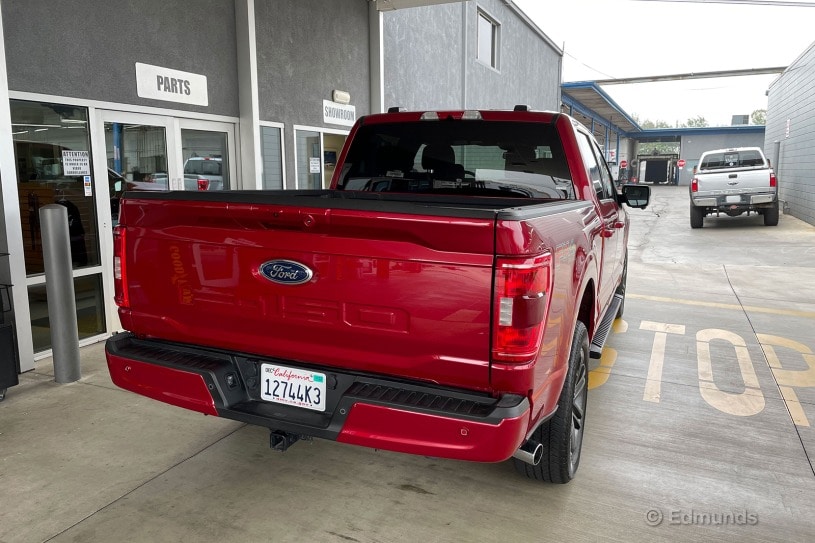
Six months into our F-150 test and it just turned 10,000 miles, which puts us right on track for our annual goal. This milestone also means it’s time for scheduled maintenance. Our dealership experience was seamless at Huntington Beach Ford. We dropped the truck off at 8 a.m. and it was ready by noon.
We spent $75 for an oil change oil, a new oil filter, a tire rotation and a list of inspections prescribed by the owner’s manual. Two recalls were also performed under warranty. The first (21S56) required a peek underneath to confirm underbody insulators weren’t sagging onto the driveshaft. The second (22S17) reprogrammed the integrated trailer relay module.
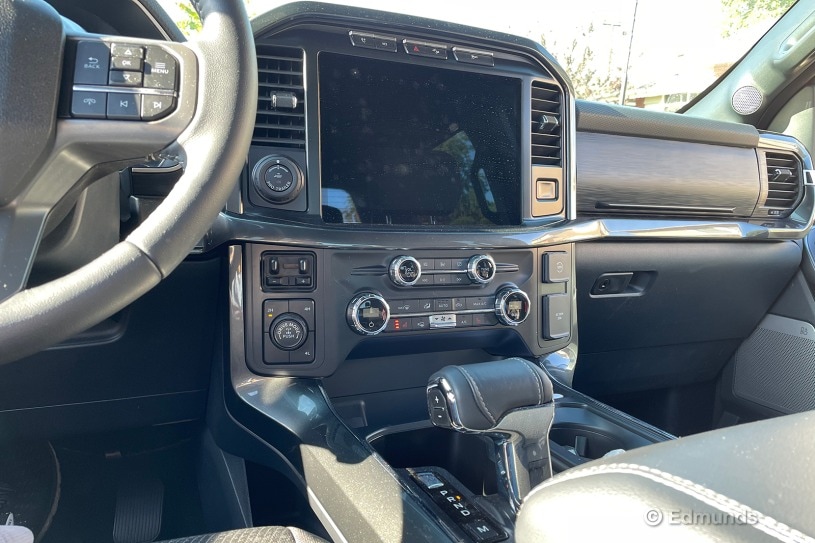
Mike Schmidt, our senior manager of vehicle testing operations, started noticing some problems with the big screen in our F-150. Things did not get much better.
“This morning the primary display screen in the F-150 started glitching on me. Without warning the screen reset itself. It would black out, or white out, then the reboot screen with the Ford logo would appear and then it very slowly reloaded.”
“I’ve been in the truck on and off again for the past four hours and this happens about every five minutes.”
Here’s what our Huntington Beach Ford adviser had to say:
“Ford pointed out a TSB (TSB 22-2226) for your screen issue, which consists of an update to the APIM module. But first the battery has to be above 10 volts for the tech to update or it can wipe the module entirely. So it takes some time to charge the battery.”
“I’ve seen this happen several times now, on F-150s, Fusions and Explorers. One customer has been here three times to get this same reboot. That’s because the APIM module has to fail in a specific way before Ford will warranty its replacement.”
When the work was done, our adviser said, “Based on what I’ve seen of this problem, I bet you are back again soon. I hope not.”
Shortly after I left I put the truck in reverse. The cameras weren’t working. I called the adviser and he said, “I was going to call you. I just found out that your truck did fail the guided test routine, so a new APIM module was ordered. They are on back order … I think because of the chip shortage. I will call you when we know more but the last one I ordered took about a month before I knew anything.”
Follow-up: The second time I started the truck after its “repair,” the primary screen was black again and fully inoperable. No map. No radio. No cameras. No voice commands. No clock. No CarPlay. Just old-school pickup truck.
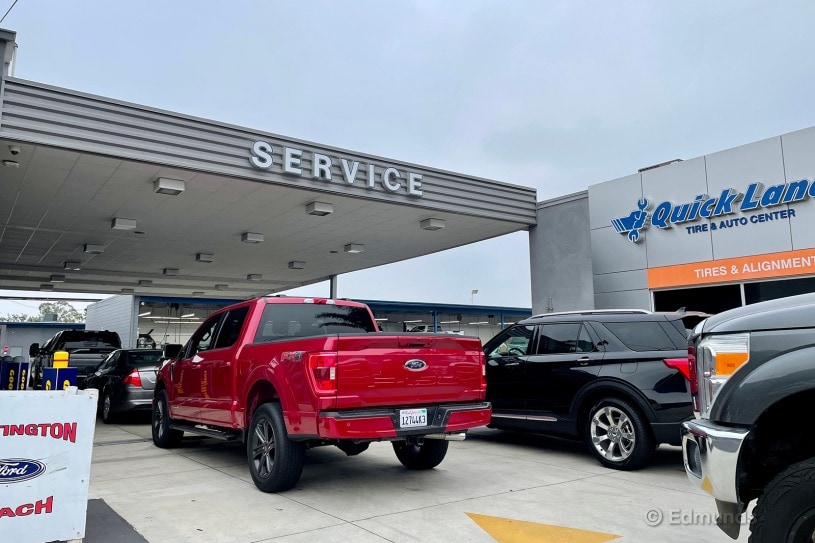
Editorial Assistant Jake Sundstrom picked up the baton from here:
“The APIM module for our F-150 arrived just over a week after Huntington Beach placed it on order (our service rep mentioned this was a very quick turnaround for this part) and the repair was completed same day (and under warranty). We can now, mercifully, listen to all of the summer jams we want while tooling around town in our beautiful, hybrid machine.”
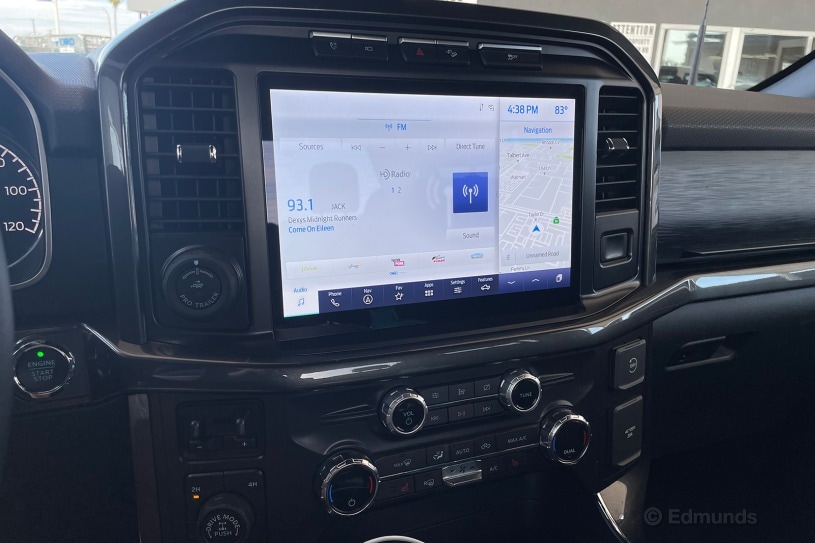
The tires have been replaced (and now repaired)
“I was late to post an update on our F-150 Hybrid and karma taught me a lesson. Two weeks ago we replaced the Hankook Dynapro AT2 tires on our truck. The cost to do so was $1,424.
“The process couldn’t have been easier in large part to Cody at the Huntington Beach America’s Tire store. He found the tires and got them to his shop the same afternoon. They were mounted, balanced and on our truck first thing the next morning. I should’ve reported this then.
“By waiting I clearly upset the cosmos and was delivered a rainy-day flat tire this morning. It could’ve been worse. I was able to air up the tire in my driveway and it held long enough to reach the same America’s Tire two blocks away. An inspection of the inner sidewall showed no structural damage, also good news. This time the turnaround was not as quick. Still the flat was repairable and done at no charge.” — Mike Schmidt, associate director, vehicle operations
We had some body damage on our F-150 repaired
“Our F-150 Hybrid was unintentionally damaged on the right side of the bed. The damage wasn’t substantial but definitely noticeable; some denting and paint scratches. We took it to a local body shop (Herman’s Auto Body) and the repair was completed within one week. The total cost was $1,886.20. The guys at Herman’s were quick and easy to work with.” — Albert Hernandez, editorial assistant
2021 Ford F-150 Hybrid: How Does it Drive?
The big deal with this F-150 is the hybrid powertrain. Here’s what we experienced with ours.
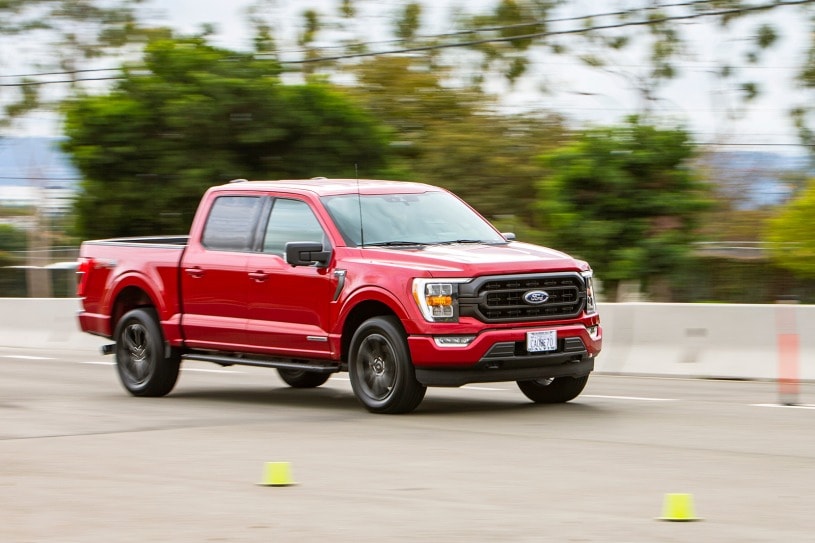
What is so different about the hybrid?
“There are a handful of driving characteristics that separate this truck from its peers.
“The first thing you hear is straight out of a spaceship. Automakers are now required by law to have an audible noise to alert pedestrians of a moving vehicle nearby. When the truck is under battery power, from 1 mph up to about 25 mph, the hum is head-turning loud. But I figure that is the whole point. Not to worry, though, you get used to it.
“Another thing is the electric-smooth acceleration from a stop. And if you ask for it, this thing really moves out. It will go from 0 to 60 mph in 5.8 seconds under normal conditions, which is just as fast as an F-150 Raptor. Yet at 24 mpg, it’s rated as fuel efficient as the 3.0-liter turbo V6 in the F-150 diesel.
“We are still in the engine break-in stage. According to the manual it’s 1,000 miles before we’re finished. During this time the transmission is still learning our driving habits, so shifts are a little erratic at times and especially during stop-and-go. We’ll cut the truck some slack until that milestone appears on the odometer. It may be psychological, but after a couple hundred miles I think it’s a little better than it was brand-new at 25 miles.” — Mike Schmidt, senior manager, vehicle testing operations

We know the hybrid has torque, but what’s that like driving up steep grades?
“‘The Grapevine (the nickname given to the mountain highway pass connecting southern California to central California) isn’t officially part of Edmunds’ testing regiment but it’s been part of my driving life since long before I got behind the wheel. As a lived-all-over-California kinda guy, I’ve spent a lot of time traversing the slopiest (?) portion of Interstate 5 in vehicles that weren’t pleased with the task.
“The F-150, in its full-hybrid configuration, didn’t break a sweat. This is not the hybrid Sienna, which sounds like an angry weed whacker driving up and down the hills. No, the F-150 merely handles the job. It hurt the fuel economy on the tank (down to around 18 mpg from Orange County to the Central Valley) but … in a full-size pickup? That still feels like a miracle.” — Jake Sundstrom, Editorial Assistant
“My wife and I loved how cozy we felt inside the cabin, but I think it has a lot to do with how well this truck performed. The ride quality was astounding and the truck hardly made a fuss about traveling through various different grades of roads. The hybrid powertrain was strong in every situation we drove through, including steep slopes, winding roads, snow, and wet roads. Our long trip allowed me to test several drive modes, including Normal, Eco, Sport and Deep Snow, and I can attest to this truck’s superb capabilities.” — Albert Hernandez, editorial assistant
The hybrid motor makes an interesting noise
“I put several hundred miles on our long-term F-150 Hybrid and came away greatly impressed overall. It’s unfortunate that we’re not getting the EPA-projected fuel economy, but that aside there’s a lot to like about the smooth power delivery and instant torque from this engine.
“One quirk, though, is the noises it makes, and I don’t mean the DOT-mandated low-speed noisemaker. The drivetrain makes weird clicks and whirrs when the electric motor is engaged. To be clear, it’s not the worst sound, and if you have the radio on you may not notice it, it’s just strange that it’s so audible. We’re used to a totally seamless experience in modern hybrids, with the engine turning on and off almost imperceptibly and the electric motors making little to no sound at all. I won’t go so far as to say it’s a ‘flaw,’ but it caught my attention.” — Keith Buglewicz, managing editor
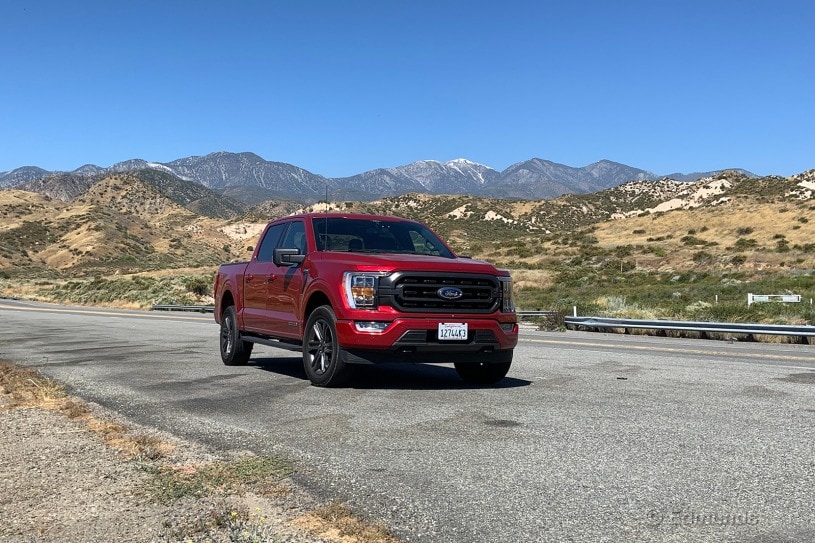
The powertrain of the F-150 Hybrid leaves something to be desired
“The hybrid’s biggest weakness in terms of powertrain, at least from my time in it, is braking. It can just get a little … clunky. It’s not every stop, but I’ve noticed a few conditions where it feels like the transition to physical braking isn’t super smooth, and then the gas engine cuts out and there’s a bit of an extra hitch in the braking force. The pedal’s pretty numb, too, so it’s not like you can feel anything happening through your foot, you feel it all in the body. It’s not that braking is weak, or difficult; it’s just not always as smooth as you’d like.” — Will Kaufman, video content manager
The F-150 is great at low speeds
“My commute involves hills with speed limits between 25 and 45 mph, and I really like the way the F-150 Hybrid handles them. The gas engine stays low in the rev range, and the electric motor provides enough torque that you can change speed a little without getting a bunch of shifts. It was actually a little off-putting at first because I kept expecting the engine to bog, but the F-150 stayed smooth and easy.” — Will Kaufman, video content manager
2021 Ford F-150 Hybrid: Ride and Seat Comfort
Here’s how our F-150 Hybrid drove over nearly 50,000 miles of ownership
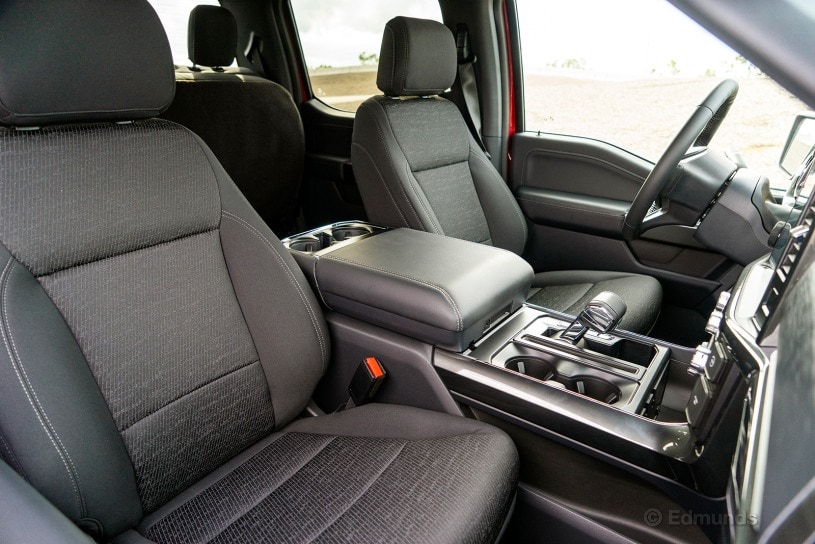
So how is the ride quality?
“The F-150 is a tremendously capable vehicle, but I’ve typically thought of it as very narrowly proficient. A week of driving our hybrid F-150 from Orange County to Sonoma County added ‘great road tripper’ to its list of superlatives. Handily tackling wet days at state parks wasn’t a surprise (that’s kind of the point of having a truck), but it dealt with long stretches on I-5 better than our brand-new BMW X3 in terms of comfort and ride quality while getting between 18 and 22 mpg. Not too shabby!” — Jake Sundstrom, editorial assistant
“This thing rocks on road trips. The seats are comfortable, the tech is easy to use, and when loaded up it never lags up any grade. Mindlessly easy to log miles.” — John Adolph, supervising producer
“I drove the F-150 Hybrid with my wife and 18-month-old child over 320 miles to Topaz Lake and it was delightful. I have to emphasize how comfortable this truck is. The seats are perfectly plush and the noise level in the cabin is pleasantly low. The ride quality has much to boast about as well as we drove through hills, winding roads and broken pavement with without disturbance.” — Albert Hernandez, editorial assistant
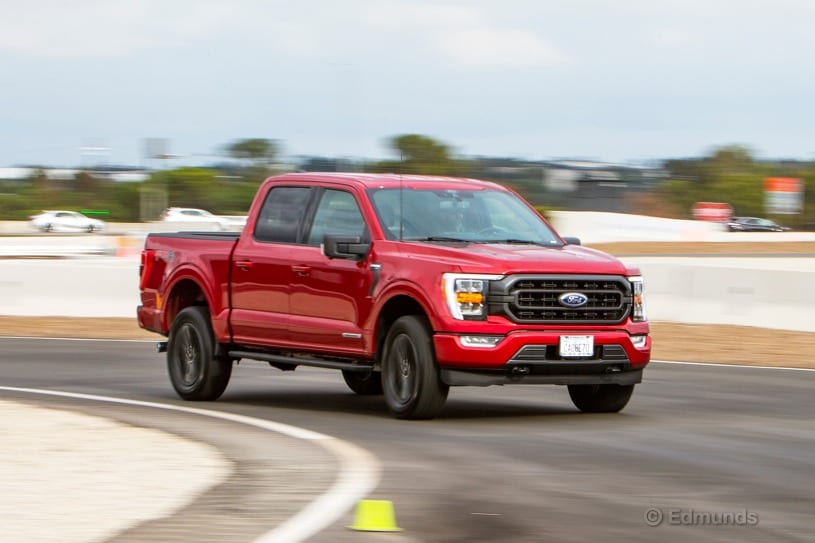
Is this the best driving light-duty truck?
“It is for me. I really like the way our F-150 drives. It’s got a pretty comfortable ride, stable handling, direct steering, smooth brakes and unobstructed visibility. I thought the same of our previous long-term test of a 2018 F-150. And then on top of all that we’ve got the muscular power of the hybrid powertrain. Mash the gas and this thing moves out with authority. Of all the light-duty trucks, the F-150 is my favorite. It’s a truck but it doesn’t drive like a truck.” — Brent Romans, senior manager, written content
The F-150 is a road-trip hero
“I’ll add on to what my co-workers have said about our F-150’s long-distance driving capability: It rocks. I drove about 700 miles over the course of a few days and came away hugely impressed. The seats are good for the long haul, the ride is decently smooth, and the powertrain gets this truck moving with authority when you need it. Oh, and the cab is massively spacious for rear passengers, too. Of all our long-term test vehicles in the past five years or so, this is easily my favorite for taking road trips.” — Brent Romans, senior manager, written content
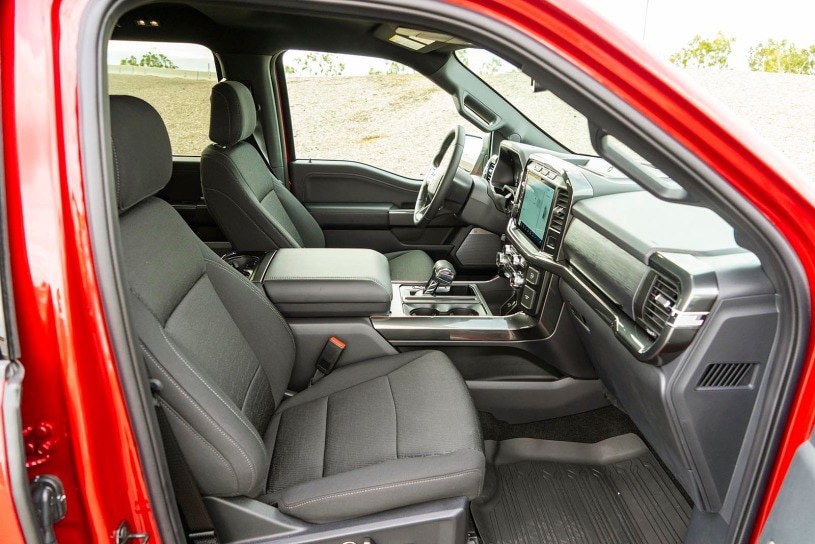
We like the seats!
“I like a good cloth seat, and these are pretty good cloth seats. It’s clearly not a premium choice (Land Rover wool this ain’t), but it’s just really compliant. My bum tells me it’s getting more sink than I do with the F-150’s leather upholstery, and it makes longer drives a bit more pleasant. I love ventilated seats, and I’m sad you can’t get cooled cloth seats, but if I were buying a truck for myself I’d have a hard time checking the box for leather even if it got me other upgrades I want.” — Will Kaufman, video content manager
2021 Ford F-150 Hybrid: Technology
The F-150 has been our favorite truck for years. How did this year’s F-150 stack up in the technology department?
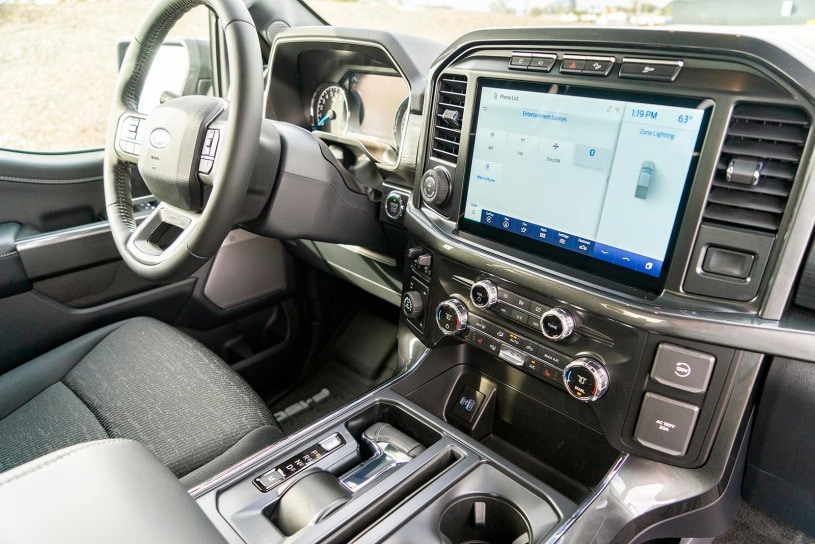
I really like our F-150 Hybrid, and I am by no means a truck guy. I don’t need anything this big on a day-to-day basis, but it’s been really great around town, save for a few tech hiccups. We’ve already talked about the replacement touchscreen, but I’ve had some strange audio issues too. I regularly use Apple CarPlay, especially for navigation, as I have work, home and a few other places pinned. CarPlay is wireless, too, and connects quicker than most vehicles I’ve used it in.
But on a couple of occasions, I had experienced an issue where audio would only play from one speaker. It wasn’t like I’d shifted the sound focus; I double checked the audio settings to see if that was the issue. The music just wouldn’t play, and because the song I was listening to was in stereo, I only heard part of the music. Switching to the radio or turning on a podcast didn’t change things. What did fix it was turn-by-turn navigation.
When the turn-by-turn voice popped on, the audio was suddenly coming through normally. I replayed some songs and experienced no further issues. Obviously, this isn’t as big an issue as the entire center screen going out, but it’s still frustrating to see small tech issues like this continue to plague an otherwise pretty great truck.
2021 Ford F-150 Hybrid: Interior
This is where you’ll spend most of your time. Let us tell you all about the spacious cabin, seat versatility and all those little comforts that make the drive go smoother.
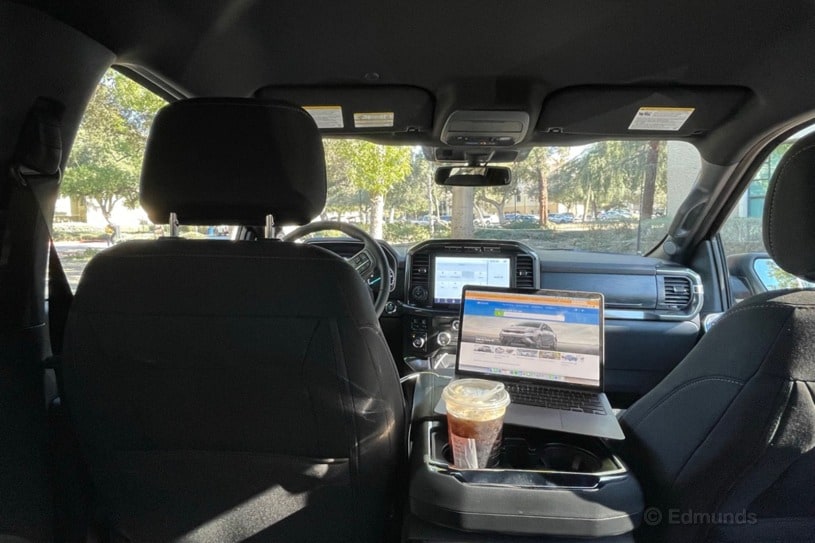
The F-150’s cabin is versatile when it’s moving, and when it’s parked
“This is the first time I’ve used the F-150 for something resembling its god-given purpose: work. I threw the truck in park, popped it into accessory mode and moved into the backseat where I’m more comfortable than any cafe I’ve ever sat in — a bonus? I get to pick the music in here!” — Jake Sundstrom, Editorial Assistant
We should have gotten the Interior Work Surface
“One of the cooler things available in the current-generation F-150 is the foldout desk, which Ford calls the Interior Work Surface. Our long-term Lightning has it. Press a button next to the shift handle on the center console and it drops down into a little well, allowing you to flip the center console bin lid forward to create a big, flat workspace for your computer, notepad, etc. Pretty handy if you’re a contractor, or just someone who likes to doodle in parking lots.
“Our Hybrid doesn’t have the desk, but it does have the fold-down handle. Am I the only one who thinks that’s odd? Why include half a feature that by itself offers little utility? The motorized handle is a nifty parlor trick, I suppose, and maybe the aftermarket can come up with something to put there when it’s folded. But the little cha-cha the handle does when it returns to its upright position doesn’t inspire confidence, and I’m not sure I like the idea of a failure point being introduced to the truck with no clear-cut benefit.” — Keith Buglewicz, managing editor
“Our other long-term F-150, the electric Lightning, has a center console feature that Ford calls the Interior Work Surface. It’s a hinged top of the console that flips down to cover the area where the gear shift handle is. I’ve found it to be useful for putting a laptop computer or food, if I have to eat in the truck. Alas, our red F-150 doesn’t have this option, and I miss it. I’d totally get this option if I were buying an F-150.” — Brent Romans, senior manager, written content
The interior is quite nice despite not being a premium trim
“Ford did a really nice job with this interior. I don’t always get a chance to drive mid- or low-trim examples of different cars, so by default the truck interiors I usually see are the ones with leather (or ‘leather’) hot-glued to every surface. But the plastic and rubber in our XLT is great. There are a ton of different textures and consistencies, even some neat patterns and designs. The metal-flake style plastic around the center stack is a way better choice than piano black or fake chrome, and it hasn’t really accumulated scratches like I’d expect.
“And this is only the second trim level up! There are four trim levels above this! What a great example of making your more accessible product still feel good.” — Will Kaufman, video content manager
2021 Ford F-150 Hybrid: Utility
You call it payload; we call it truck stuff. Here’s how our F-150 Hybrid held up.
Camping with generator mode
“Editor Jake Sundstrom took the F-150 for a weekend getaway recently. He reflected, “The F-150 can be thrown into generator mode, which effectively prevents the truck from shutting off on its own while idling. You can also turn on EcoBoost mode, which tells the truck to rev harder in order to create more electricity for the hybrid’s battery. That can come in handy if you’re using either of the outlets in the bed for long periods of time. Or when it gets very, very cold in the middle of the night while camping in the desert and you need the truck to keep producing warm air.
“… My trip also gave me a chance to use the anchor points in the bed for a couple of tie downs. The included anchor points worked great and it only took a couple of straps to secure a midsize load that included a cooler, a large box and other camping bags.”
“I made a similar comment about Pro Power Onboard for our long-term F-150, so I might as well write it about our F-150 Hybrid, too. You might wonder: Is it worth getting? Well, it really depends on what your needs are. I figure there are four main situations where having a bunch of household-style power outlets and the ability to power them using the engine can come into play: 1) tailgating (power a TV, stereo, household appliances); 2) camping (similar); 3) at a work-related job site (power tools); and 4) home power outages.
“The first one, admittedly, isn’t my thing. Camping could be but I haven’t used our F-150 for it. Number three: Dammit, Jim, I’m an automotive journalist, not a construction worker! So that leaves home power outages. And well, I haven’t encountered one of those while driving our truck, either.
“I have played around with PPO — I hooked up an electric hedge trimmer to one of the outlets located in the bed. And sure enough — bzzzzz! — I was hacking away at a bush in my front yard using F-150 power. Ultimately, my take is this: For certain F-150 owners (see needs 1-3 above), it’s worth getting. And for the fourth possibility, it might come in handy, but I wouldn’t get PPO for that reason alone.” Brent Romans, senior manager, written content
Have truck, will fill with random stuff
For now, we’ll just park a carousel of photos here with things we’ve hauled in the F-150’s bed.
Our only needs for the F-150 so far consist of those little things that are unimpressive conveniences to a truck owner but are heaven-sent for non-truck-owners. We used the tie-down cleats and eye hooks to keep a fleet of rental tables and chairs from bouncing out. We brought that scrap wood home so the kids could build a weekend project. We picked up that bicycle. We easily loaded up those bags of mulch from the local nursery. Stay tuned for more.
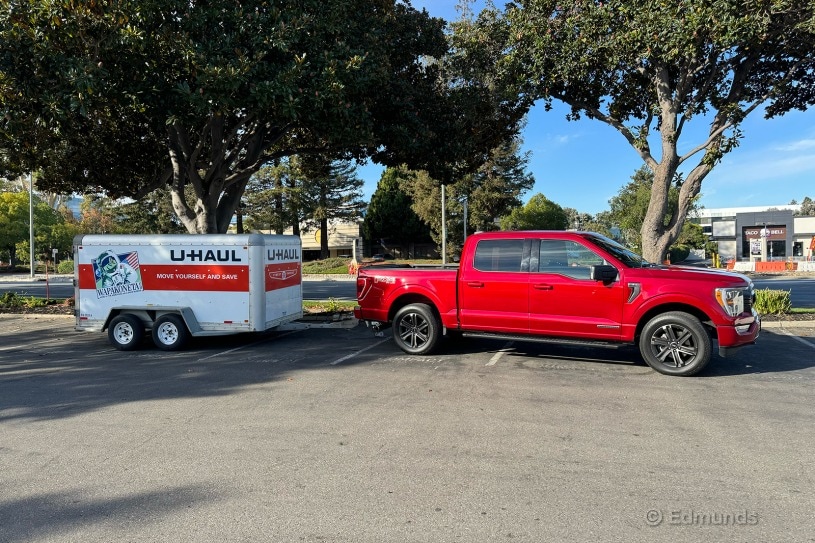
“I love the fold-up rear bench in this truck. Yes, the ginormous bed is terrific for anything I’m willing to expose to the elements, but the cargo area in the rear of the cab is useful in a way I hardly have to think about.” — Jake Sundstrom, editor
“The F-150’s bed gets the majority of utility praise, as well it should. But the rear seat area deserves a quick shoutout for its fold-up seats.
“I recently used the Ford to move a bunch of items that I didn’t feel comfortable leaving out in the open on a long drive. So I folded up the rear seatbacks and stuffed it all in there. The cargo area handily swallowed all of the cardboard boxes full of dishes and antiques, a few paintings, and other items that don’t do well exposed to the elements. Even with all the boxes there was plenty of visibility over them to the rear, and the broad, flat floor made it easy to load and unload. Plus, I really liked the peace of mind that comes with knowing everything was in a locked area during driving breaks.” — Keith Buglewicz, CarMax managing editor
As the saying goes, “have F-150, will use F-150 to move”
“This truck was an absolute lifesaver for my move. It fit the vast majority of a married couple’s one-bedroom place (including some furniture) in two trips. We were able to stuff the cabin to the brim and load up the bed, and the truck seemed to not even notice. The smooth power and ride comfort meant that not only did I enjoy the ride, but I felt comfortable that all of my fragile items and things riding in the bed were safe. The multitude of tie-down locations ensured that I was able to position my belongings and straps so that everything was secure. The biggest compliment I have is that after the two days of putting it through a move and LA traffic, I genuinely started to think about what it would be like to own.” — David Lucio, post production coordinator
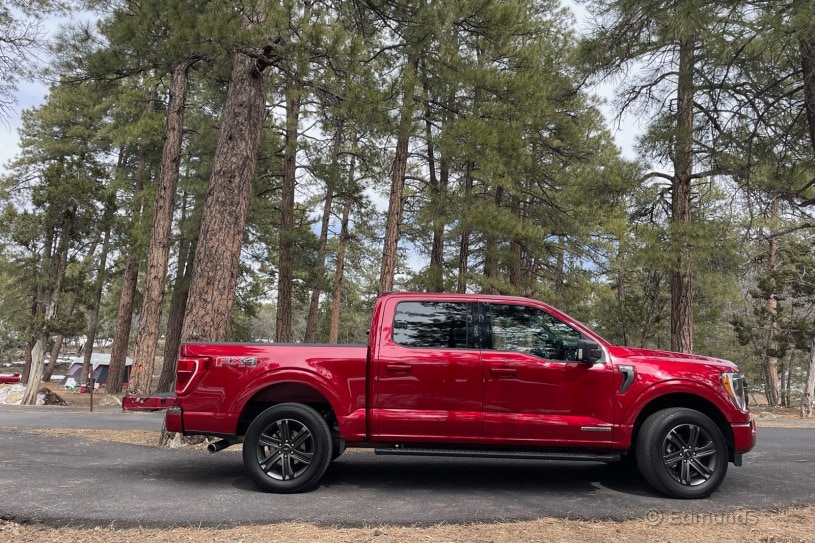
Another National Park off the list!
“We can cross another National Park off our F-150 Hybrid’s bucket list — the Grand Canyon. There was still snow on the ground, but none on the roads, and the F-150 once again proved a great camping companion. This time we opted to stuff everything into the cab rather than the bed. We threw some firewood and water containers into the bed but otherwise were able to pack all our camping gear into the back of the cab by folding up the rear seats.” — Jake Sundstrom, editor
2021 Ford F-150 Hybrid: Miscellaneous
If it didn’t fit somewhere else, it ended up here.
The F-150 is a very good truck
“Our F-150 Hybrid has almost 30K miles on the clock, and I totally get why. It’s such a great GADA truck, I can’t imagine anyone ever being sad about having to drive this thing, no matter what the circumstances. If it had adaptive cruise control and front parking sensors, it’d be perfect.” — Will Kaufman, video content manager
Which F-150 do we prefer?
“Hybrid vs. Lightning? I’d take the Hybrid all day. Do I wish the real-world fuel economy was better? Yes, absolutely. But leaving aside cost (the Hybrid was like $20K less than the Lightning), flexibility (the Lightning has plenty of range for my life), and performance (I don’t need a truck as fast as the Lightning; the Hybrid is still quicker than a truck needs to be, thank you), the elephant in the room is … the elephant. The Lightning’s added weight tells every day — especially over all the humps and bumps on LA’s streets, where you can feel the suspension fighting that extra 1,000 pounds.” — Will Kaufman, video content manager



